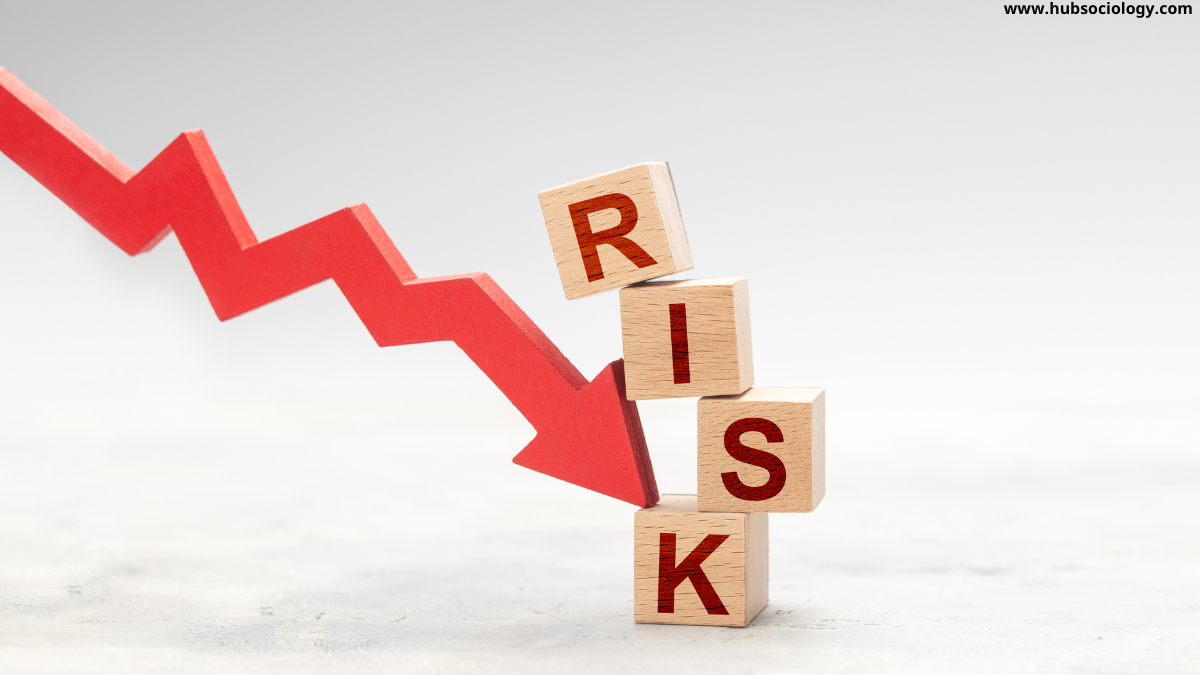Introduction on Understanding Risk in Sociology
Risk is an inevitable part of human life and social existence. From health hazards, economic uncertainties, and environmental disasters to technological failures, individuals and societies constantly face situations involving risk. Traditionally, risk has been understood in terms of probability and uncertainty, often studied within economics, engineering, or natural sciences. However, in sociology, the concept of risk has a deeper meaning—it reflects not only the probability of harm but also the social structures, cultural values, and institutional frameworks that shape how people perceive, experience, and manage risk. Understanding risk sociologically allows us to see it as a socially constructed phenomenon influenced by history, culture, power relations, and collective responses.
This article examines the concepts and elements of risk in sociology, highlighting how risk is understood, perceived, and managed within social contexts.

Table of Contents
Concept of Risk in Sociology
In everyday terms, risk is associated with uncertainty about the future and the possibility of loss or harm. In sociology, risk is not just a neutral or objective calculation—it is shaped by social meanings, discourses, and practices. Three central ideas help in understanding the sociological concept of risk:
- Risk as Socially Constructed
- Risk is not purely objective but constructed through human interpretation. The same event may be considered risky in one culture and normal in another. For example, nuclear energy may be seen as a symbol of progress in one society but as a threat in another.
- Risk and Modernity
- Sociologists like Ulrich Beck and Anthony Giddens have argued that modern societies are characterized by new kinds of risks—technological, environmental, and global—that differ from traditional risks such as famine or war. Beck, in his influential work Risk Society (1992), argues that modernity produces risks that are man-made, unpredictable, and transnational, such as climate change, genetic engineering, and terrorism.
- Risk as Power and Control
- Risk is also tied to issues of power. Governments, corporations, and institutions often control how risks are defined, communicated, and managed. For instance, industries may downplay environmental risks to protect profits, while marginalized groups may face higher exposure to those very risks.
Elements of Risk in Sociological Perspective
Sociologists identify several core elements of risk that shape how it is perceived and managed:

1. Uncertainty
- At the heart of risk lies uncertainty about the future. Risk involves making decisions without full knowledge of the outcome. In sociology, uncertainty is not only technical but also social. For example, how a society responds to a pandemic depends not just on medical uncertainty but also on trust in government, cultural attitudes toward health, and the flow of information.
2. Perception and Culture
- Different societies perceive risks differently based on cultural values and collective experiences. Mary Douglas’s Cultural Theory of Risk emphasizes that risk perception is shaped by cultural worldviews. For example, some communities may view natural disasters as acts of fate, while others see them as failures of planning or governance.
3. Knowledge and Expertise
- Risk is closely linked with knowledge production. Scientific experts, policymakers, and media play a role in defining what counts as a “real risk.” However, this knowledge is not neutral—it can be contested and influenced by political and economic interests. The debate over genetically modified foods, for example, reflects conflicting claims of scientific safety versus public skepticism.
4. Social Inequality
- Risk is not equally distributed in society. Vulnerable groups—such as the poor, minorities, or those living in hazardous areas—are more exposed to environmental and health risks. This is often referred to as the social distribution of risk. Sociologists highlight that risks reinforce social inequalities, as wealthier groups can often avoid or mitigate risks, while disadvantaged populations bear the burden.
5. Institutional Management
- Institutions such as governments, regulatory agencies, and international organizations manage risks through policies, regulations, and interventions. However, their effectiveness depends on legitimacy and trust. Failures in institutional management can lead to crises of confidence, as seen in cases of industrial accidents, pandemics, or financial collapses.
6. Globalization and Transnational Risks
- In the global age, risks transcend national boundaries. Climate change, cybercrime, terrorism, and pandemics are global risks that require international cooperation. Sociology examines how globalization creates interconnected vulnerabilities, making societies more dependent on global governance.
7. Communication and Media
- Media plays a central role in shaping public perception of risk. The way risks are reported can amplify fear (risk amplification) or downplay dangers (risk attenuation). Sociologists note the phenomenon of the “risk society of fear,” where constant exposure to risk-related news generates widespread anxiety.
Risk Society: Ulrich Beck’s Perspective
Ulrich Beck’s theory of the “Risk Society” is one of the most influential sociological approaches to risk. According to Beck:
- Modern society is no longer primarily concerned with the distribution of wealth but with the distribution of risk.
- Unlike traditional risks, modern risks are man-made, invisible, and global in scope.
- Risks such as radiation, chemical pollution, and climate change cannot be easily contained within geographical boundaries.
- Modern societies are forced to rely on expert systems to detect and assess risks, leading to tensions between laypeople and experts.
Beck’s concept highlights the paradox of progress: the very technologies designed to improve human life also generate new risks that are harder to predict and control.
Sociological Theories of Risk
Several theoretical perspectives contribute to understanding risk:
- Cultural Theory (Mary Douglas and Aaron Wildavsky)
- Suggests that risk perceptions are shaped by cultural values and social solidarity.
- Systems Theory (Niklas Luhmann)
- Views risk as an outcome of decision-making within complex social systems.
- Governmentality (Michel Foucault)
- Examines how risk is used as a tool of governance, where states manage populations through strategies of risk prevention, regulation, and surveillance.
These theories underline that risk is not just about probability but also about meaning, control, and social organization.
Contemporary Examples of Risk in Society
- COVID-19 Pandemic
- Exposed global health risks, inequalities in access to healthcare, and the role of misinformation in shaping perceptions.
- Climate Change
- A global risk affecting vulnerable populations disproportionately, raising questions of environmental justice.
- Technological Risks
- Issues like artificial intelligence, data privacy, and cyber threats show how innovation creates both opportunities and uncertainties.
- Economic Risks
- Financial crises demonstrate how interconnected economies amplify risks across nations.
Conclusion on Understanding Risk in Sociology
Risk in sociology is more than a technical assessment of probability—it is a socially embedded phenomenon. It is shaped by culture, institutions, power structures, and inequalities. The study of risk helps us understand not only how individuals and societies respond to uncertainty but also how risk reflects deeper issues of modernity, globalization, and governance.

By analyzing the concepts and elements of risk, sociology provides insight into how societies construct meaning around uncertainty, how risks are distributed unequally, and how institutions manage threats in an increasingly interconnected world. Ultimately, understanding risk sociologically equips us to recognize that it is not only about danger but also about opportunity, adaptation, and collective responsibility in shaping a safer and more equitable future.
Do you like this this Article ? You Can follow as on :-
Facebook – https://www.facebook.com/hubsociology
Whatsapp Channel – https://whatsapp.com/channel/0029Vb6D8vGKWEKpJpu5QP0O
Gmail – hubsociology@gmail.com
Topic-related questions on Understanding Risk in Sociology
5 Marks Questions on Understanding Risk in Sociology
- Define risk from a sociological perspective.
- What does Ulrich Beck mean by the term Risk Society?
- Mention two elements of risk in sociology.
- How does media influence public perception of risk?
- Explain briefly the cultural construction of risk.
10 Marks Questions on Understanding Risk in Sociology
- Discuss the role of uncertainty in shaping sociological understanding of risk.
- Explain Mary Douglas’s Cultural Theory of Risk with suitable examples.
- How is risk distributed unequally across different social groups?
- Examine the role of institutions in managing risks in modern societies.
- How has globalization transformed the nature and scale of risks?
15 Marks Questions on Understanding Risk in Sociology
- Critically evaluate Ulrich Beck’s theory of the Risk Society.
- Discuss the major elements of risk in sociology with relevant illustrations.
- Analyze the relationship between risk, knowledge, and power in contemporary society.
- Examine the role of globalization in creating transnational risks such as climate change and pandemics.
- Compare and contrast different sociological theories of risk (Cultural Theory, Systems Theory, Governmentality).
